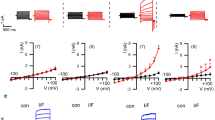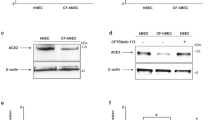Abstract
Sendai virus (SeV) vector has been shown to efficiently transduce airway epithelial cells. As a precursor to the potential use of this vector for cystic fibrosis (CF) gene therapy, the correct maturation of the SeV vector-derived CF transmembrane conductance regulator (CFTR) protein was examined using biochemical and functional analyses. We constructed a recombinant SeV vector, based on the fusion (F) gene-deleted non-transmissible SeV vector, carrying the GFP-CFTR gene in which the N terminus of CFTR was fused to green fluorescence protein (GFP). This vector was recovered and propagated to high titers in the packaging cell line. Western blotting using an anti-GFP antibody detected both the fully glycosylated (mature) and the core-glycosylated (immature) proteins, indicating that SeV vector-derived GFP-CFTR was similar to endogenous CFTR. We also confirmed the functional channel activity of GFP-CFTR in an iodide efflux assay. The efficient expression of GFP-CFTR, and its apical surface localization, were observed in both MDCK cells in vitro, and in the nasal epithelium of mice in vivo. We concluded that recombinant SeV vector, a cytoplasmically maintained RNA vector, is able to direct production of a correctly localized, mature form of CFTR, suggesting the value of this vector for studies of CF gene therapy.





Similar content being viewed by others
References
Kerem B, Zielenski J, Markiewicz D, Bozon D, Gazit E, Yahav J et al. Identification of mutations in regions corresponding to the two putative nucleotide (ATP)-binding folds of the cystic fibrosis gene. Proc Natl Acad Sci USA 1990; 87: 8447–8451.
Anderson MP, Berger HA, Rich DP, Gregory RJ, Smith AE, Welsh MJ . Nucleoside triphosphates are required to open the CFTR chloride channel. Cell 1991; 67: 775–784.
Sheppard D, Welsh MJ . Structure and function of the CFTR chloride channel. Physiol Rev 1999; 79: S23–S45.
O'Riordan CR, Lachapelle AL, Marshall J, Higgins EA, Cheng SH . Characterization of the oligosaccharide structures associated with the cystic fibrosis transmembrane conductance regulator. Glycobiology 2000; 10: 1225–1233.
Bradbury NA . Intracellular CFTR: localization and function. Physiol Rev 1999; 79: S175–S191.
Yonemitsu Y, Kitson C, Ferrari S, Farley R, Griesenbach U, Judd D et al. Efficient gene transfer to airway epithelium using recombinant Sendai virus. Nat Biotechnol 2000; 18: 970–973.
Ferrari S, Griesenbach U, Shiraki-Iida T, Shu T, Hironaka T, Hou X et al. A defective nontransmissible recombinant Sendai virus mediates efficient gene transfer to airway epithelium in vivo. Gene Therapy 2004; 11: 1659–1664.
Ferrari S, Griesenbach U, Iida A, Farley A, Wright AM, Zhu J et al. Sendai virus-mediated CFTR gene transfer to the airway epithelium. Gene Therapy (in press).
Moyer BD, Loffing J, Schwiebert EM, Loffing-Cueni D, Halpin PA, Karlson KH et al. Membrane trafficking of the cystic fibrosis gene product, cystic fibrosis transmembrane conductance regulator, tagged with green fluorescent protein in madin-darby canine kidney cells. J Biol Chem 1998; 273: 21759–21768.
Loffing-Cueni D, Loffing J, Shaw C, Taplin AM, Govindan M, Stanton CR et al. Trafficking of GFP-tagged F508-CFTR to the plasma membrane in a polarized epithelial cell line. Am J Physiol Cell Physiol 2001; 281: C1889–C1897.
Haggie PM, Stanton BA, Verkman AS . Diffusional mobility of the cystic fibrosis transmembrane conductance regulator mutant, F508-CFTR, in the endoplasmic reticulum measured by photobleaching of GFP-CFTR chimeras. J Biol Chem 2002; 277: 16419–16425.
Oceandy D, McMorran B, Schreiber R, Wainwright BJ, Kunzelmann K . GFP-tagged CFTR transgene is functional in the G551D cystic fibrosis mouse colon. J Membr Biol 2003; 192: 159–167.
Li HO, Zhu YF, Asakawa M, Kuma H, Hirata T, Ueda Y et al. A cytoplasmic RNA vector derived from nontransmissible Sendai virus with efficient gene transfer and expression. J Virol 2000; 74: 6564–6569.
Bitzer M, Armeanu S, Lauer UM, Neubert WJ . Sendai virus vectors as an emerging negative-strand RNA viral vector system. J Gene Med 2003; 5: 543–553.
Tokusumi T, Iida A, Hirata T, Kato A, Nagai Y, Hasegawa M . Recombinant Sendai viruses expressing different levels of a foreign reporter gene. Virus Res 2002; 86: 33–38.
Finkbeiner WE, Carrier SD, Teresi CE . Reverse transcription-polymerase chain reaction (RT-PCR) phenotypic analysis of cell cultures of human tracheal epithelium, tracheobronchial glands, and lung carcinomas. Am J Respir Cell Mol Biol 1993; 9: 547–556.
Howard M, Jiang X, Stolz DB, Hill WG, Johnson JA, Watkins SC et al. Forskolin-induced apical membrane insertion of virally expressed, epitope-tagged CFTR in polarized MDCK cells. Am J Physiol Cell Physiol 2000; 279: C375–C382.
Pickles RJ, Fahrner JA, Petrella JM, Boucher RC, Bergelson JM . Retargeting the coxsackievirus and adenovirus receptor to the apical surface of polarized epithelial cells reveals the glycocalyx as a barrier to adenovirus-mediated gene transfer. J Virol 2000; 74: 6050–6057.
Pickles RJ . Physical and biological barriers to viral vector-mediated delivery of genes to the airway epithelium. Proc Am Thorac Soc 2004; 1: 302–308.
Wilson JM . Adeno-associated virus and lentivirus pseudotypes for lung-directed gene therapy. Proc Am Thorac Soc 2004; 1: 309–314.
Zhang L, Peeples ME, Boucher RC, Collins PL, Pickles RJ . Respiratory syncytial virus infection of human airway epithelial cells is polarized, specific to ciliated cells, and without obvious cytopathology. J Virol 2002; 76: 5654–5666.
Zhang L, Bukreyev A, Thompson CI, Watson B, Peeples ME, Collins PL et al. Infection of ciliated cells by human parainfluenza virus type 3 in an in vitro model of human airway epithelium. J Virol 2005; 79: 1113–1124.
Inoue M, Tokusumi Y, Ban H, Kanaya T, Shirakura M, Tokusumi T et al. A new Sendai virus vector deficient in the matrix gene does not form virus particles and shows extensive cell-to-cell spreading. J Virol 2003; 77: 6419–6429.
Inoue M, Tokusumi Y, Ban H, Shirakura M, Kanaya T, Yoshizaki M et al. Recombinant Sendai virus vectors deleted in both the matrix and the fusion genes: efficient gene transfer with preferable properties. J Gene Med 2004; 6: 1069–1081.
Yoshizaki M, Hironaka T, Iwasaki H, Ban H, Tokusumi Y, Iida A et al. Naked Sendai virus vector lacking all of the envelope-related genes: reduced cytopathogenicity and immunogenicity. J Gene Med 2006; 8: 1151–1159.
Inoue M, Tokusumi Y, Ban H, Kanaya T, Tokusumi T, Nagai Y et al. Nontransmissible virus-like particle formation by F-deficient Sendai virus is temperature sensitive and reduced by mutations in M and HN proteins. J Virol 2003; 77: 3238–3246.
Kobayashi M, Iida A, Ueda Y, Hasegawa M . Pseudotyped lentivirus vectors derived from simian immunodeficiency virus SIVagm with envelope glycoproteins from paramyxovirus. J Virol 2003; 77: 2607–2614.
Mitomo K, Griesenbach U, Inoue M, Tabata T, Ueda Y, Fujikawa S et al. New pseudotyping with Sendai virus glycoproteins realized very long-term gene expression in airway epithelia by simian immunodeficiency virus vector. 13th Annual Congress of the European Society of Gene Therapy 2005, 16 Abs18.
Griesenbach U, Mitomo K, Inoue M, Somerton L, Farley R, Singh C et al. Lentivirus pseudotyped with envelope proteins F and HN from Sendai Virus transduce airway epithelium efficiency and persistently. Mol Ther 2006; 13 (Suppl.1) Abs 367: 139–140.
Sakai Y, Kiyotani K, Fukumura M, Asakawa M, Kato A, Shioda T et al. Accommodation of foreign genes into the Sendai virus genome: sizes of inserted genes and viral replication. FEBS Lett 1999; 456: 221–226.
Kato A, Sakai Y, Shioda T, Kondo T, Nakanishi M, Nagai Y . Initiation of Sendai virus multiplication from transfected cDNA or RNA with negative or positive sense. Genes Cells 1996; 1: 569–579.
Niwa H, Yamamura K, Miyazaki J . Efficient selection for high-expression transfectants with a novel eukaryotic vector. Gene 1991; 108: 193–199.
Hirata T, Iida A, Shiraki-Iida T, Kitazato K, Kato A, Nagai Y et al. An improved method for recovery of F-defective Sendai virus expressing foreign genes from cloned cDNA. J Virol Methods 2002; 104: 125–133.
Derand R, Bulteau-Pignoux L, Becq F . Comparative pharmacology of the activity of wild-type and G551D mutated CFTR chloride channel: effect of the benzimidazolone derivative NS004. J Membr Biol 2003; 194: 109–117.
Acknowledgements
We acknowledge B Moss for supplying vTF7-3; H Iba for supplying pCALNdLw; H Taira for supplying anti-F antibody; T Kanaya, K Washizawa, S Fujikawa and N Kurosawa for their excellent technical assistance. Members of the UK CF Gene Therapy Consortium are funded by the Cystic Fibrosis Trust.
Author information
Authors and Affiliations
Corresponding author
Rights and permissions
About this article
Cite this article
Ban, H., Inoue, M., Griesenbach, U. et al. Expression and maturation of Sendai virus vector-derived CFTR protein: functional and biochemical evidence using a GFP-CFTR fusion protein. Gene Ther 14, 1688–1694 (2007). https://doi.org/10.1038/sj.gt.3303032
Received:
Revised:
Accepted:
Published:
Issue Date:
DOI: https://doi.org/10.1038/sj.gt.3303032
- Springer Nature Limited
Keywords
This article is cited by
-
Cigarette Smoke Exposure Induces Retrograde Trafficking of CFTR to the Endoplasmic Reticulum
Scientific Reports (2019)
-
Sendai virus-mediated gene transfer of the c-myc suppressor far-upstream element-binding protein-interacting repressor suppresses head and neck cancer
Gene Therapy (2015)
-
Toward Gene Therapy for Cystic Fibrosis Using a Lentivirus Pseudotyped With Sendai Virus Envelopes
Molecular Therapy (2010)




